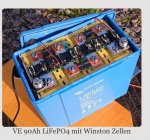Poey50
Well-Known Member
We still experimenting we found whats works best at the moment , abs 14v float 13.5v seen to be about right dropping the abs on13.8v on sunny days , soon we be using less induction hob and mico waves the electric rad as already been put away so we won't be using so much then and I will set Abs to 13.8v no point charging higher if I don't need to.
once a month I increase charging to Abs 14.1v .
At 14.1v the different in cells are nothing , as it get close to 14.2 cells 3 slowly start to drift 14.3v would see cells 3 hitting 3.65 while the others are within 0.01 of each of the other cells
Whats strange and it may be normal is cell 3 is always .01/.02 behind all the other cells until it reaches 14.2v
I not tested at 14.4v as I know cell 3 will be pass 3.65v
See photos at 14v
Our 8 cells are in a 2P4S so we can use just one bms in reality each module it reading 2 cells as one, now if thats causing the different in reading as the cell get close to 3.65 dont know .
I wouldn't say I'm dissatisfied they seen to be working OK but for the money its more of a diy kit then a complete bms , Module are very easy to damage and as you know you have to go to the expense of adding relays to protect the batteries where many bms have protection build in .
If you add the full cost of the 123 plus relays you can buy a much better quality like the orion, which is what i would go for if I did it again.
Personally I don't thing 123smart are suitable for boats , on land sure even a RV .
Vic,
A few points ...
Keep in mind that the quoted accuracy of voltage measurement for the 123SmartBMS is + or - 20mV so that 0.01 or 0.02 difference you are seeing may or may not be significant. What is the largest difference between cells when the first reaches 3.65 volts?
As far as modules go, if you remove the outside case of the top of the range Victron lithium battery you will find pretty much the same thing (see below). The boards just need to be protected from any external damage. I have a cover over my pack so they can't get damaged. Integrated units also have thin wires leading to the terminals that need protecting - in the case of the Electrodacus, very thin indeed, judging by the Will Prowse video.
Only cheaper BMSs have current passing through them. Orion and REC both use external contactors. It is the best way for higher charge and discharge.
Soldering on wires to the boards does irritate some people. For me it is a basic skill and it means I could choose the size of wire to best fit the ring terminal.
That said, if doing it again, I would go for something that would control my charging devices directly (although that has its own disadvantage of relying on the BMS entirely) but that comes at a higher cost than I was willing to pay. The app and ease of configuring remotely via Bluetooth are all of course excellent features of the 123Smart.
Attachments
Last edited:

